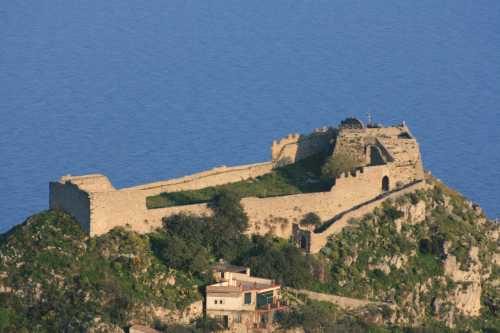
Castello Saraceno di Taormina
Il Castello di Taormina è una fortificazione che si erge sulla rocca del Monte Tauro ad un altezza di 400 metri s.l.m.. In età greca e romana, la Rocca del Tauro era l’acropoli inferiore di Tauromenion. Il castello era una importante postazione militare posta tra l’Etna ed i Peloritani da cui si controllava la valle dell’Alcantara. Secondo alcune fonti il castello fu costruito dagli Arabi, ma non si ha certezza del periodo in cui è stato realizzato.
Il Castello di Taormina è famoso per la difesa che oppose all’invasione Musulmana dell’isola.Si sa con certezza che fu il baluardo degli Arabi nel 1079 durante l’assedio dei Normanni e che il Conte Ruggero escogitò una tattica militare per impedire ai Saraceni l’approvvigionamento, facendo costruire intorno al muro di cinta ventidue Torri di legno, che impedirono il rifornimento di viveri agli Arabi, che dopo pochi mesi di battaglia capitolarono.Durante il dominio di Federico II il castello venne affidato ad un nobile castellano. I muri esterni sono ben conservati, al contrario di quelli interni che sono quasi del tutto crollati.
(English)
Saracen Castle of Taormina
The Castle of Taormina is a fortification that stands on the rock of Monte Tauro at a height of 400 meters above sea level. In the Greek and Roman age, the Rocca del Tauro was the lower acropolis of Tauromenion. The castle was an important military post located between Etna and the Peloritani from which the Alcantara valley was controlled. According to some sources the castle was built by the Arabs, but there is no certainty of the period in which it was built.
The Castle of Taormina is famous for the defense it opposed to the Muslim invasion of the island. It is known with certainty that it was the bulwark of the Arabs in 1079 during the siege of the Normans and that Count Roger devised a military tactic to prevent the Saracens from supplying, by having twenty-two wooden towers built around the perimeter wall, which prevented the supply of food to the Arabs, who capitulated after a few months of battle. During the dominion of Frederick II the castle was entrusted to a noble castellan. The external walls are well preserved, unlike the internal ones which have almost completely collapsed.